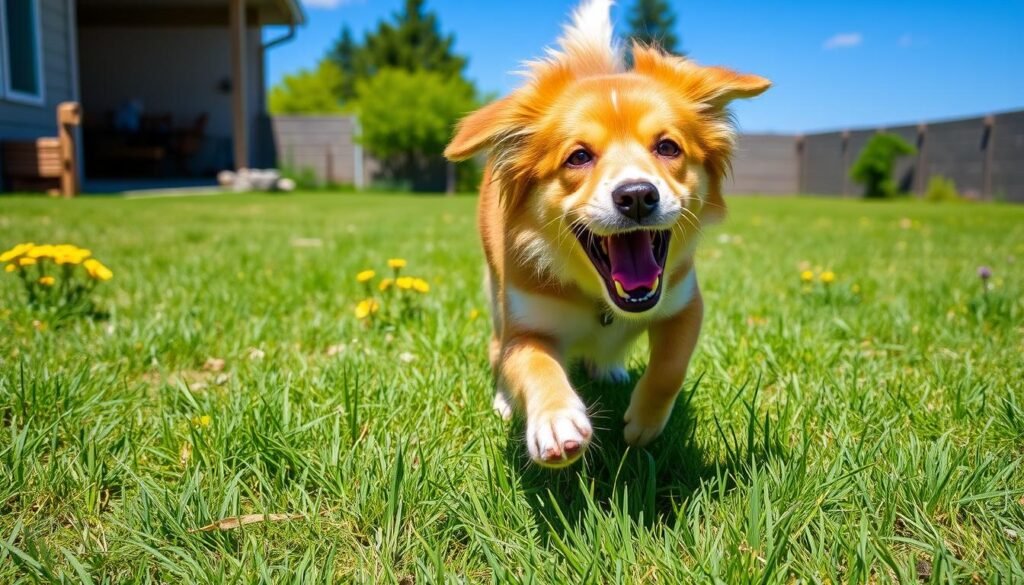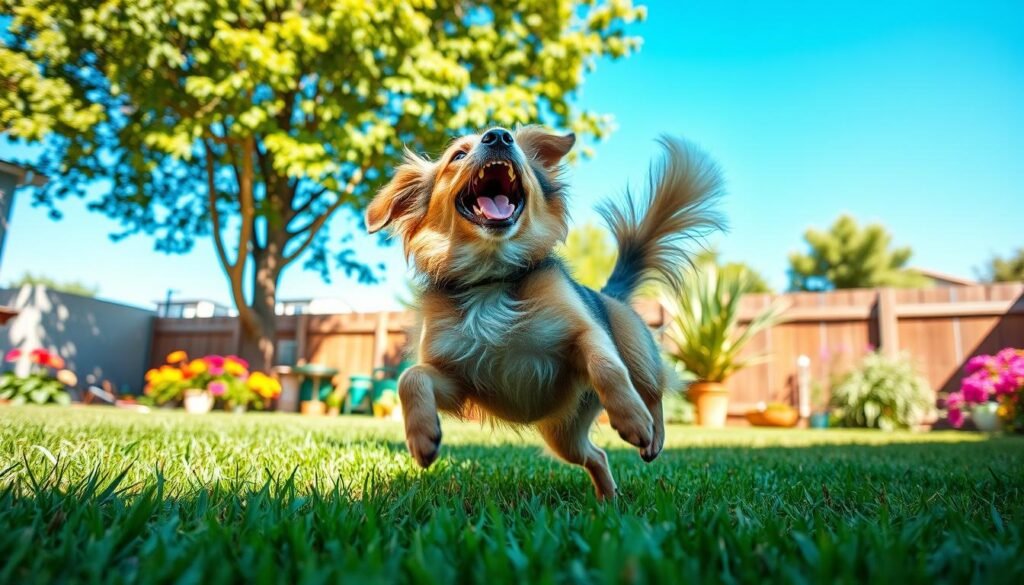Did you know up to 10% of dogs bite or chew their tails? This common issue makes pet owners wonder what causes it. It’s important to understand why your dog might do this, as it often shows his health and mood.
We’ll look at the reasons behind this behavior, like skin issues and psychological problems. By knowing these causes and finding solutions, we can keep our dogs happy and healthy. If you see your dog biting his tail, it’s a sign to act for his well-being.

Understanding the Causes of Dog Tail Biting
Knowing why dogs bite their tails is key for pet owners. Many things can cause this behavior. By figuring out the reasons, we can help our pets feel better.
Skin Problems and Allergies
Skin issues like allergies can really bother dogs. Flea and tick allergies can cause skin problems. This makes dogs bite their tails a lot.
About 30% of dogs get allergies to fleas and ticks. Environmental allergies affect 10% of dogs. They can start showing signs between three months and six years old. Common allergens include pollen, dust, and certain foods. A lot of tail biting comes from skin problems.
Injury and Pain Responses
Injuries can make dogs bite their tails due to pain. Around 20% of dogs bite and gnaw because of injuries. Impacted anal glands also cause tail biting in up to 10% of dogs.
These dogs might scoot or have a bad smell. It’s important to notice injuries early. Quick action can stop the pain and tail biting.
Behavioral Issues: Anxiety and Boredom
Emotions play a big part in dog behavior. Anxiety and boredom are big reasons for tail biting. Dogs left alone for too long often get anxious and bite their tails.
About 40% of dogs with behavioral problems bite their tails. Boredom makes dogs do compulsive things, affecting over 50% of them. Helping dogs feel less stressed can make them happier.

My Dog Won’t Stop Biting His Tail: Signs to Watch For
It’s important to notice if your dog seems uncomfortable or has hidden problems. Spotting these signs early can help solve the issue of tail biting.
Visible Signs of Discomfort
Look for visible signs of discomfort if your dog bites his tail a lot. Check for:
- Hair loss at the tail’s base
- Redness or irritation on the skin
- Sores or wounds from too much biting
- Unpleasant odors, which might mean an infection
These signs usually mean there’s a problem that needs fixing.
Behavioral Changes and Symptoms
Also, watch for behavioral changes dog tail biting. Dogs might show:
- Restlessness or trouble settling down
- Getting upset when their tail is touched
- Struggling to find a comfy spot to sit
- More anxiety or avoiding certain things
Seeing these signs can help you understand how your dog feels and their overall health.

| Visible Signs of Discomfort | Behavioral Changes |
|---|---|
| Hair loss | Restlessness |
| Redness or irritation | Irritability |
| Sores | Struggling to sit comfortably |
| Foul odor | Increased anxiety |
Why Is My Dog Biting His Tail? Spotting the Root Causes
Figuring out why is my dog biting his tail helps find the right solutions. Knowing the reasons behind this behavior is key. Tail biting can be due to health issues, behavioral problems, or both. Watching your dog’s actions can give you important hints.
Behavioral triggers often include:
- Lack of exercise and mental stimulation
- Stress or anxiety
These factors can make your dog chew on their tail. It’s a way for them to release energy or ease discomfort. Health problems, like allergies or skin infections, also play a big role. Dogs with allergies might bite their tail to soothe itchiness.
Spotting physical health issues is important. For example, dog tail biting treatment might involve dealing with hot spots or parasites. About half of dogs face parasites like fleas or ticks, causing irritation and leading to tail biting.
Look out for these signs:
- Open wounds or signs of infection around the tail
- Symptoms linked to anal gland issues such as scooting or foul odors
- Visible discomfort or anxiety when touched near the tail area
Spotting these behaviors means you can act early. If your dog shows these signs, get vet help fast. Knowing the cause helps solve the problem.

Identifying Physical Conditions Promoting Tail Biting
It’s important to know what physical issues can lead to tail biting in dogs. Skin infections and parasites are common causes. Fixing these problems can make your dog more comfortable and stop them from biting their tail.
Skin Infections and Irritants
Skin infections often cause dogs to bite their tails. These infections can be bacterial or fungal. Keeping your dog clean and well-groomed can help avoid these problems.
If your dog does get an infection, it’s key to get vet help. This ensures they get the right treatment and avoids worse problems.
Parasites: Fleas and Ticks
Fleas and ticks can really bother your dog’s skin. Even one flea bite can make them itch a lot. This might lead them to bite their tail.
To keep your dog safe, you need to keep fleas and ticks away. Use regular treatments and take steps to prevent them.

| Condition | Symptoms | Preventive Measures |
|---|---|---|
| Skin Infections | Redness, itching, hair loss | Regular cleaning, vet visits |
| Fleas and Ticks | Itching, possible skin lesions | Flea prevention, regular check-ups |
Home Remedies for Dog Tail Biting
Home remedies are a great way for dog owners to tackle tail biting. They can soothe your dog and stop the biting. It’s all about using natural solutions.
Natural Oils and Their Benefits
Natural oils are key in calming your dog’s skin. Coconut and lavender oils can soothe inflamed skin and stop itching. Always mix these oils with a carrier oil first.
This makes them safer and more effective. Using these remedies regularly can make your dog more comfortable and less anxious.
Homemade Sprays to Deter Biting
Homemade sprays can also help stop tail biting. Mix equal parts water and apple cider vinegar to create a spray. This taste will discourage your dog from biting its tail.
But, don’t use it on open wounds as it might irritate the skin. This simple trick helps dog owners teach their pets better habits. Plus, it’s an affordable and easy way to care for your dog.
Effective Dog Tail Biting Solutions
Understanding our dogs’ needs is key to stopping unwanted behaviors like tail biting. By focusing on physical activities and creating a soothing environment, we can prevent dog tail biting. This approach helps both their physical and emotional health.
Exercise and Mental Stimulation
Regular playtime, exercise, and interactive toys can reduce boredom and anxiety. Studies show that over 60% of dogs with tail chasing aren’t getting enough exercise or mental stimulation. Activities that challenge their minds not only solve these problems but also strengthen your bond.
- Daily walks or jogs to expend energy.
- Interactive games such as fetch or hide-and-seek.
- Puzzle toys to promote mental engagement.
Creating a Calm Environment
A calm setting helps your dog feel comfortable and secure. High anxiety levels are seen in about 50% to 70% of tail-biting cases. Here are some tips for a calming atmosphere:
- Designate a quiet space for relaxation.
- Utilize calming aids like pheromone diffusers.
- Consider professional guidance from a behaviorist if anxiety persists.
By focusing on exercise and a calm atmosphere, we tackle the main causes of dog tail biting. These strategies not only solve the problem but also lead to a healthier, happier life for your pet.
| Strategy | Benefits | Impact on Dog Tail Biting |
|---|---|---|
| Regular Exercise | Reduces boredom, boosts overall health | Decreases incidence of tail chasing behavior by up to 50% |
| Mental Stimulation | Enhances cognitive function | Significantly lowers stress-induced tail biting |
| Calm Environment | Reduces anxiety and fear | Aids in dog tail biting prevention in anxious dogs |
Professional Diagnosis and Treatment Options
Seeking professional help is key when dealing with dog tail biting. Knowing when to visit a vet is important for your pet’s health. Tests help find health issues that cause tail biting.
When to See a Veterinarian
If your dog’s tail biting gets worse or shows health problems, act fast. Look for signs like redness, open sores, or constant irritation. If the behavior lasts more than two weeks, see a vet to avoid serious health issues.
Testing for Underlying Health Issues
Vets suggest tests to find health problems linked to tail biting. These might include:
- Allergy testing to find out if food or the environment is causing skin issues.
- Skin scrapings to spot parasites or infections that aren’t easy to see.
- Behavioral assessments to check for anxiety or stress-related behaviors.
These steps help find the cause of tail biting and improve your dog’s health. By understanding and addressing tail biting, you can make your dog happier and more comfortable.
| Health Issue | Possible Symptoms | Recommended Test |
|---|---|---|
| Skin Allergies | Itchy skin, redness, and irritation | Allergy testing |
| Skin Infections | Sores, swelling, and discharge | Skin scraping |
| Parasites | Fleas, ticks, and excessive itching | Parasitic screening |
| Behavioral Issues | Anxiety, restlessness, and compulsive behavior | Behavioral assessments |
Dog Tail Chewing Prevention Strategies
To stop dog tail biting, you need to groom and manage their environment. Watching your dog closely helps catch the problem early. This can lower how often they bite their tail.
Regular Grooming and Maintenance
Keeping your dog clean is key to dog tail biting prevention. It helps spot skin problems early. Regular vet visits can catch health issues before they get worse.
A clean dog is less likely to bite its tail because it’s not in pain.
Creating a Flea-Free Environment
A clean home helps keep fleas away, which is good for your dog. Regular flea treatments and cleaning can prevent infestations. This reduces itching and irritation that might make your dog bite its tail.
Understanding Your Dog’s Tail Biting Behavior
Dog tail biting behavior can puzzle pet owners. It’s important to look at your dog’s temperament, experiences, and environment. This behavior can mean anxiety, boredom, or relief. Recognizing triggers helps owners to act.
Watching for patterns and situations is key. Engaging your dog in fun activities can stop tail biting. Adding mental and physical exercise to their day helps. This keeps them balanced and reduces anxiety.
Also, check if the environment affects them. Poor grooming or skin issues can cause discomfort. Keeping their space clean and visiting the vet regularly is important.
By understanding tail biting, owners can create a better life for their pets. This knowledge helps in solving the problem.
Conclusion
Figuring out why your dog bites his tail is key to their happiness. It could be due to many reasons like health issues, emotional problems, or things in their environment. Skin problems, allergies, anxiety, and boredom are just a few examples.
To stop your dog from biting his tail, watch for changes in their behavior. Keep their living area clean and make sure they have fun things to do. Taking them to the vet regularly can also help find and treat health problems early.
By being active and knowing what to do, you can make your dog’s life better. This way, you and your pet can enjoy each other’s company more. It’s all about understanding and caring for each other.
FAQ
Why is my dog biting his tail?
Dogs bite their tails for many reasons. It could be due to skin irritations, allergies, or pain from injuries. It might also be because of boredom or anxiety.
What are common dog tail biting causes?
Skin problems like allergies and infections are common causes. Boredom and anxiety can also lead to compulsive tail biting.
How can I stop my dog from biting his tail?
To stop tail biting, make sure your dog gets enough exercise and mental stimulation. Proper grooming is also key. Natural remedies or a vet’s advice can help if the behavior continues.
What remedies are effective for dog tail biting?
Natural oils and homemade sprays can soothe the skin. Engaging toys can help reduce boredom and anxiety.
How can I prevent my dog from biting his tail?
Prevent tail biting by grooming regularly and keeping your home flea-free. Engage your dog in play to keep them mentally and physically active.
Are there signs that indicate my dog is uncomfortable when biting his tail?
Yes, signs of discomfort include visible irritation and excessive licking. Your dog might also seem restless or show behavioral changes like irritability or anxiety.
When should I seek professional help for my dog’s tail biting?
Seek vet help if your dog’s tail biting is severe, causes injury, or leads to infection. Also, if it’s accompanied by severe anxiety, get professional advice.
How do I know if my dog’s tail biting behavior is due to anxiety?
Anxiety-related tail biting might be linked to other behaviors like excessive barking or restlessness. Changes in appetite can also be a sign. Watching your dog’s behavior can help spot stress triggers.
Can fleas cause my dog to bite his tail?
Yes, fleas can cause intense itching and irritation. This discomfort might lead your dog to bite or chew at their tail.
What are some signs that my dog might have a skin infection?
Signs of skin infections include redness, swelling, hair loss, sores, and a foul odor. If you notice these, see a vet right away for an evaluation.






